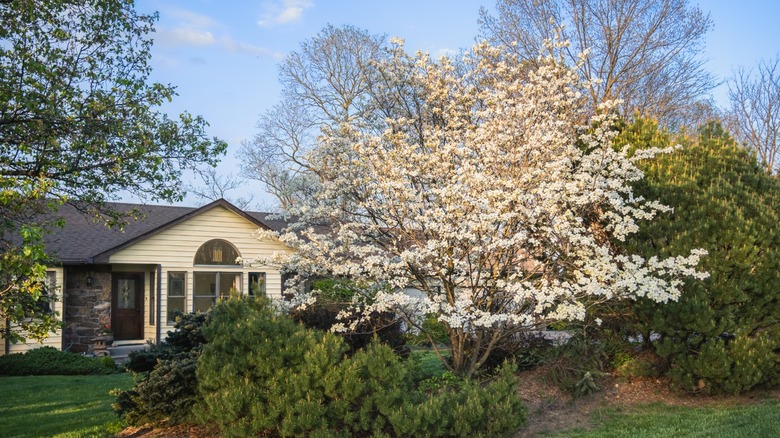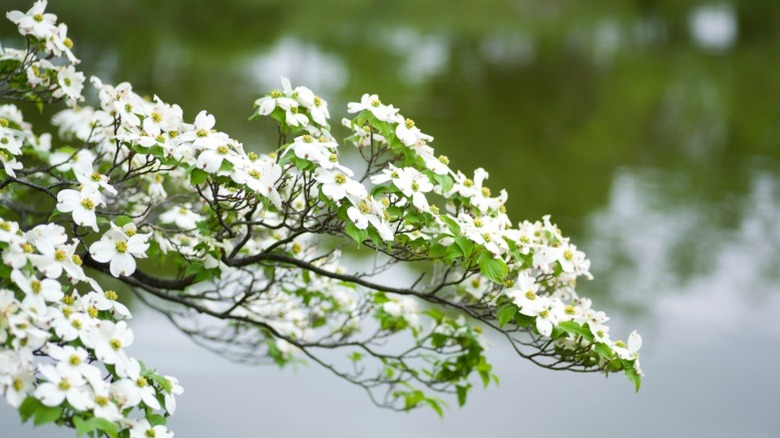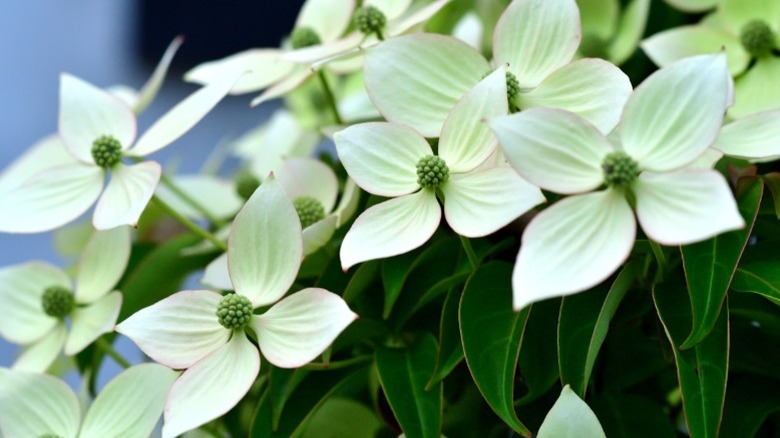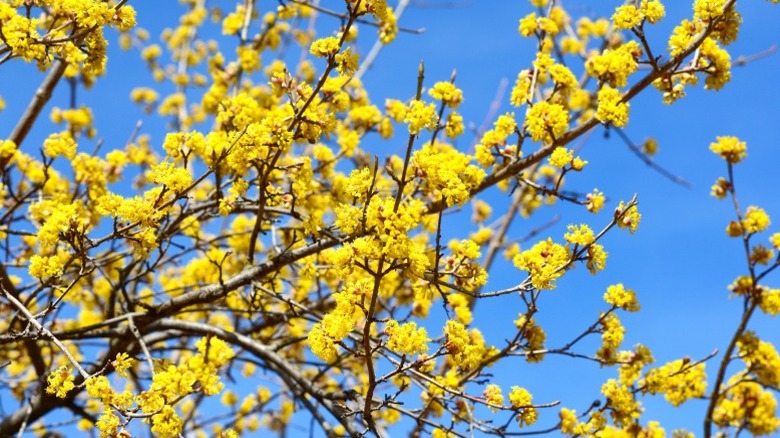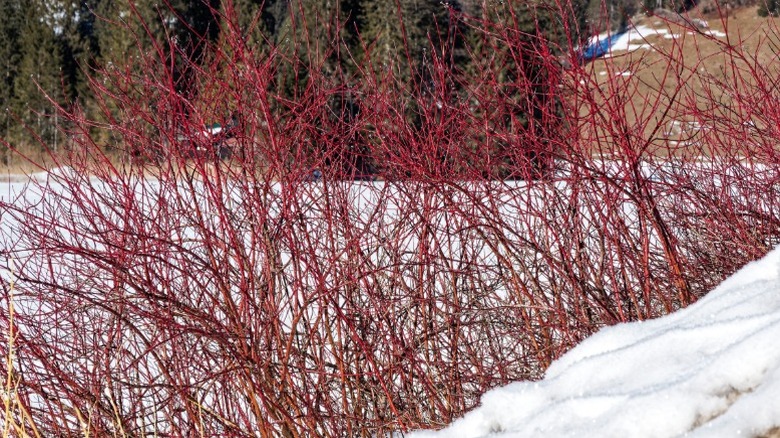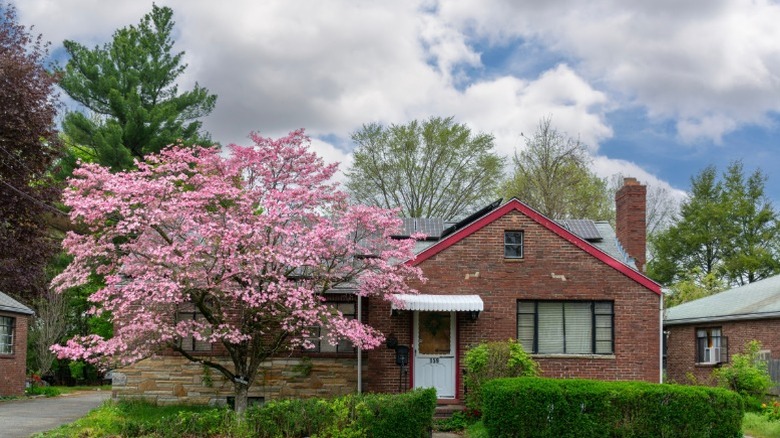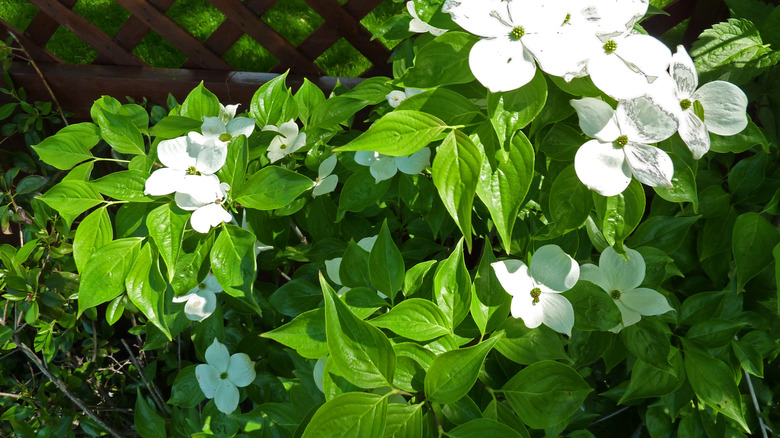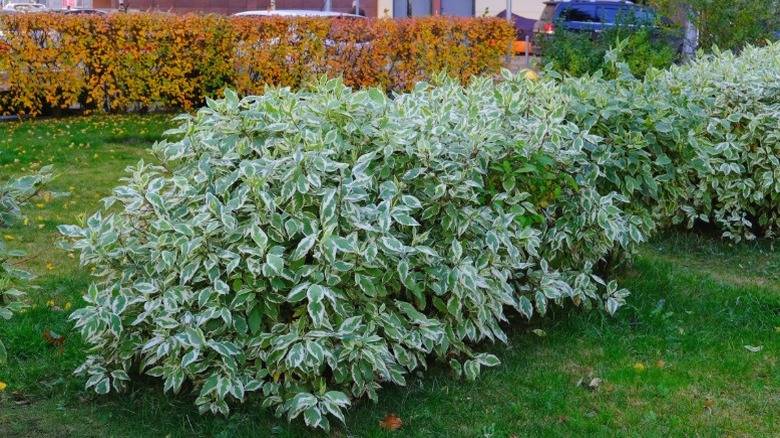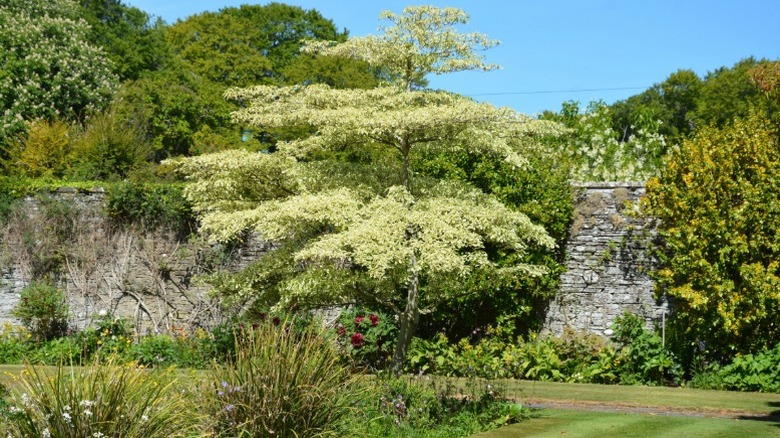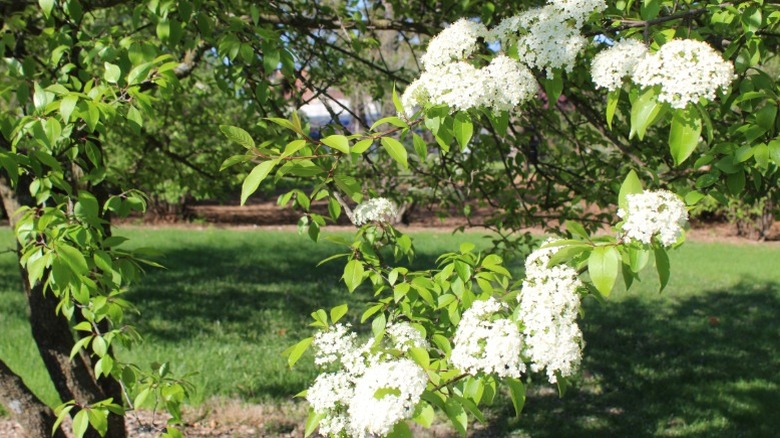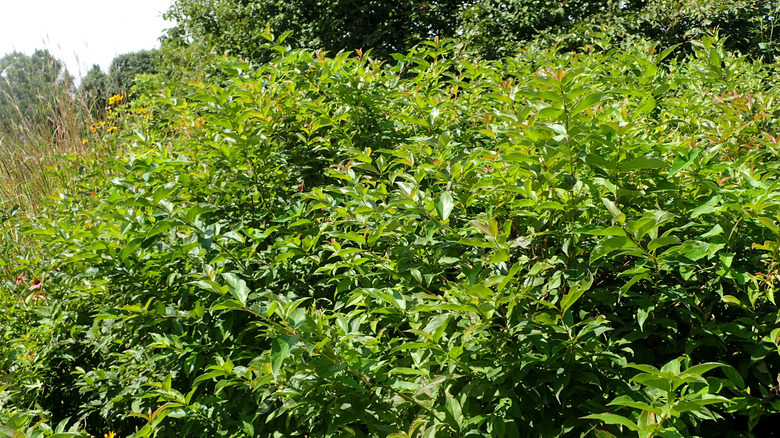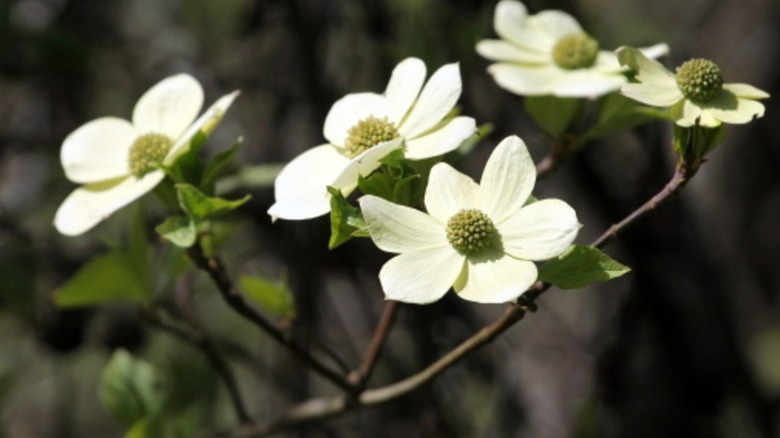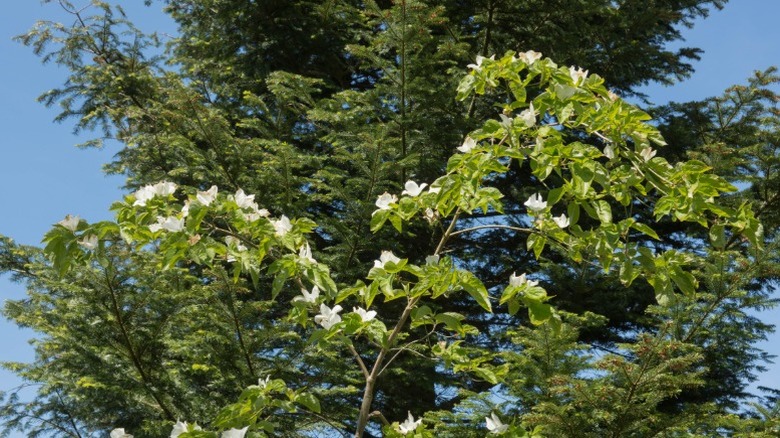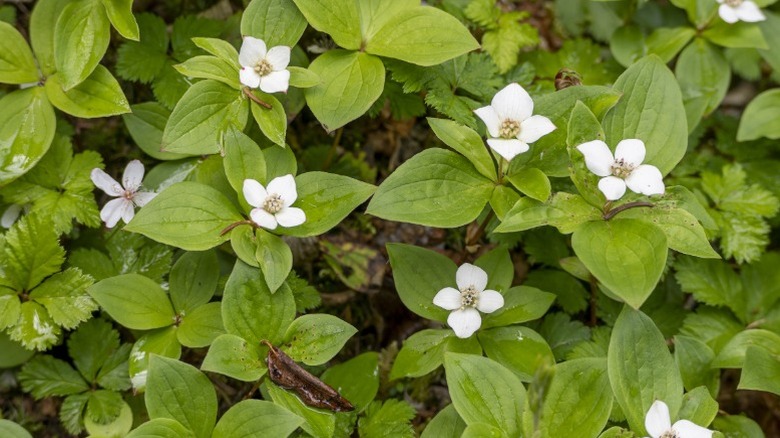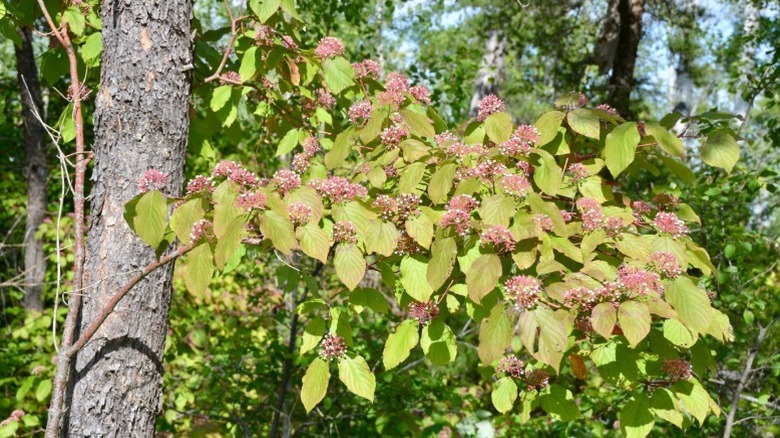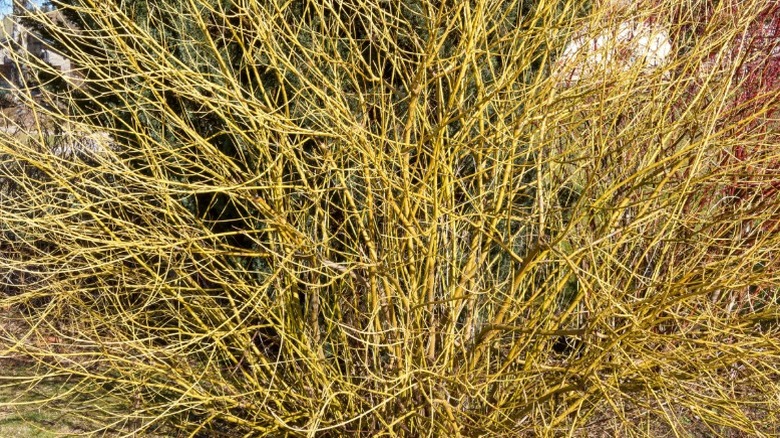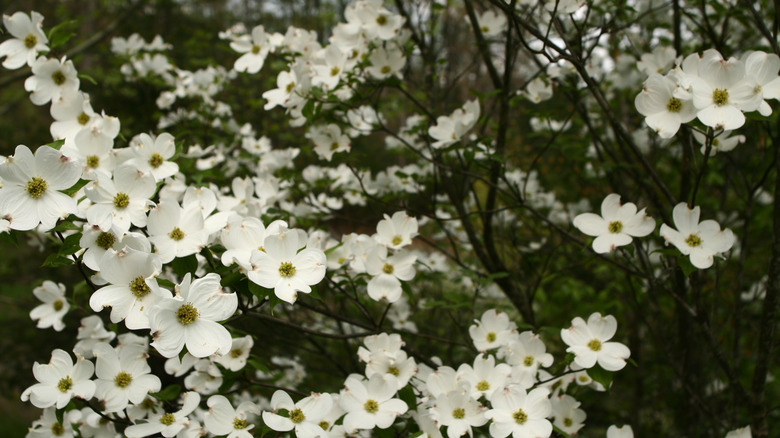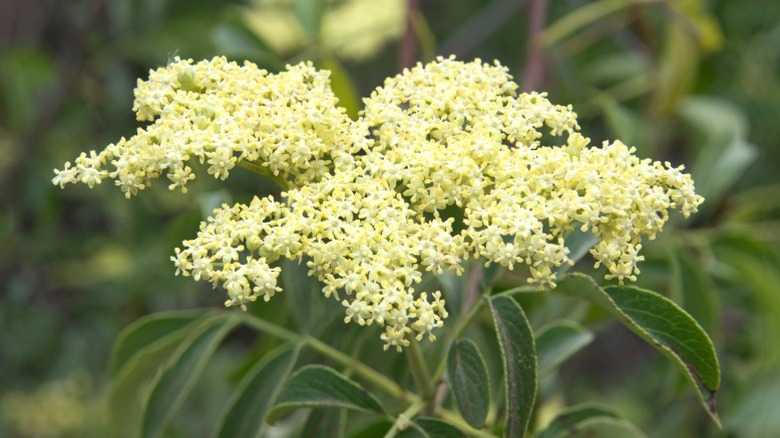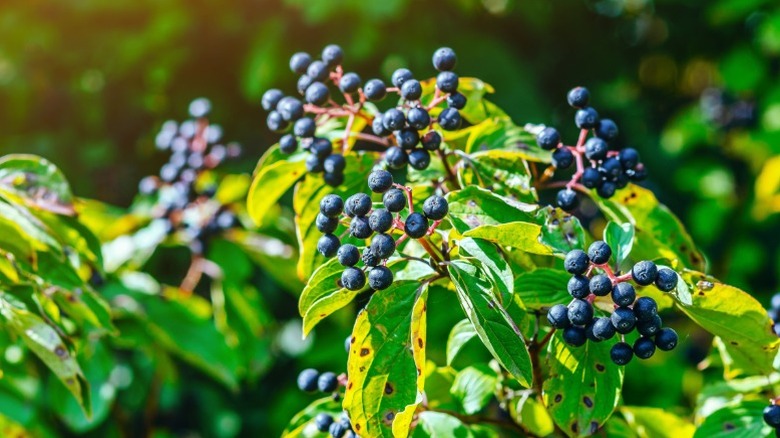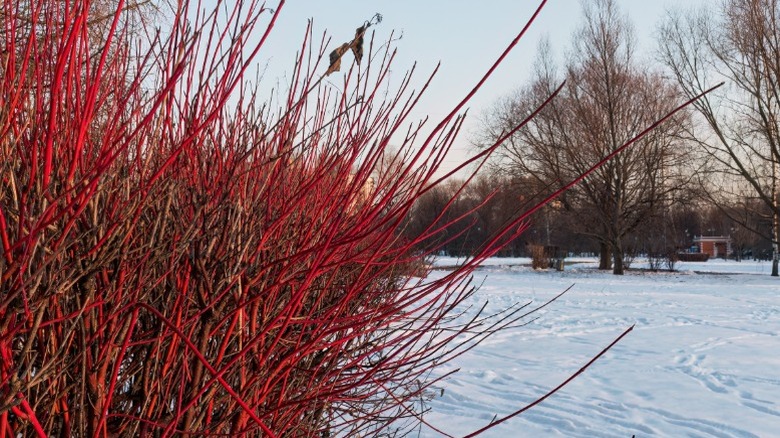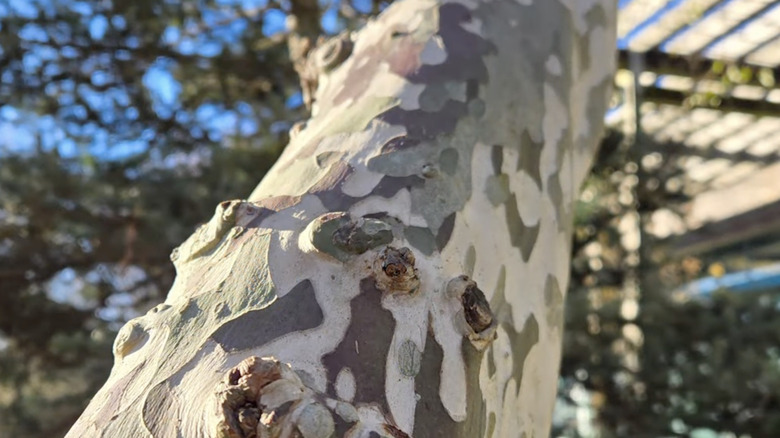20 Stunning Dogwood Tree And Shrub Varieties That Belong In Your Yard
Ornamental trees and shrubs can enliven any yard. As the seasons change, so do they, providing eye-catching displays to complement your landscaping. If you are looking to cultivate a more romantic, timeless aesthetic in your yard, consider choosing a classic for the job like a dogwood (Cornus spp.). Whether you use one to serve as a focal point in your lawn or together in a grouping, there are several inimitable species to choose from. Most dogwoods are lovely, low-maintenance trees that you will want in your landscaping for their stunning displays.
Dogwoods in the genus Cornus include a variety of beautiful and unique species. Depending on your yard, you might choose one or another variety for their ornamental value, whether you love colorful flowers, beautiful berries, or bright bark. Ranging in origin from the eastern United States to Asia, dogwood trees and shrubs represent a diverse group, from the lovely flowering dogwood to the shrubby rough-leaf dogwood. As of 2025, several shrublike dogwoods native to the U.S. were reclassified under a new genus, Swida, by taxonomists. These include the red osier dogwood and gray dogwood, but you might see these dogwood varieties still sold or spoken about as though they are still in the Cornus genus.
Flowering dogwood
Perhaps the most notable dogwood in the U.S., the flowering dogwood (Cornus florida) makes a bold shade tree or border accent. This tree gets the epithet "flowering" not from true flowers, but from bracts, which are modified leaves. This showy tree grows naturally across North America, from southeastern Canada to eastern Mexico. Enliven your yard throughout the seasons as it transforms with bright red fruit and reddish-purple leaves. The best spot to plant a flowering dogwood tree for stunning spring blooms is actually in the shade of another tree. This dogwood variety is hardy in zones 5 to 9.
Kousa dogwood
An Asian variety, the kousa dogwood (Cornus kousa) grows well in the U.S. Like flowering dogwoods, these trees feature creamy white bracts. By September or October, kousa dogwoods develop edible pink fruits that add a pop of color. Grow it as a specimen tree to highlight every season with color. A tip to remember is that while this species tolerates shade, if it shines in the sun, it displays gorgeous fall color. This dogwood variety is hardy in zones 5 to 8. Note that this species is emerging as invasive in several U.S. states and you should plant with caution.
Cornelian cherry dogwood
Depending on your preference, you can grow a Cornelian cherry dogwood (Cornus mas) as a multi-stemmed tree or a large shrub. A native to Europe, specifically the Caucasus region, these trees offer bright yellow flowers in clusters around late winter to early spring. Attractive to the human eye, Cornelian cherry dogwood trees also bring value to specialized bee species, birds, and small mammals like squirrels. Grow it to take advantage of its durability and adaptability in various conditions. This dogwood variety is hardy in zones 4 to 8.
Red osier dogwood
The red twig, or the red-osier dogwood (Cornus sericea) is a North American native common in wet, boggy landscapes. At home in damp areas of the U.S., this red-stemmed tree or shrub is a popular choice thanks to its versatility. Plant it alone or even in multiples for a bold hedge plant. Plus, this red tree is a cardinal-magnet shrub that will bring a pop of color to your yard. This cold-tolerant variety is hardy in zones 2 through 7. Grow it with success in lower, moist parts of your yard thanks to its tolerance of wet feet.
Pink dogwood
If you see a dogwood with red or pink "flowers" or bracts, it's probably a cultivar developed from the pink dogwood (Cornus florida var. rubra) that occurs naturally in the wild. However, these pinkish-reddish blooms are not very common in the wild and it's easier to find lovely cultivated versions to grow in your landscape. Look for 'Cherokee Brave' for its stunning red bracts with pale centers or 'Sweetwater Red' to enjoy deep red flowers in your yard. This dogwood variety is hardy in zones 5 to 9 like other flowering dogwoods.
Rutgers dogwood
Developed by a professor at Rutgers University, located in New Jersey, Rutgers' dogwood (Cornus x rutgersensis) are also often referred to as Stellar Hybrid dogwoods. This dogwood series is a hybrid that crosses the native flowering dogwood (Cornus florida) with the Asian dogwood (Cornus kousa). All cultivars feature showy, disease-resistant characteristics, like the 'Celestial' cultivar. Its bracts begin as white and mature to pink with sterile fruit. Grow for its ornamental value without worrying about potential invasive tendencies from a kousa dogwood. This dogwood variety is hardy in zones 5 to 9.
Tartarian dogwood
An exotic cousin of the North American native red twig dogwood, the tartarian dogwood (Cornus alba) can also be grown successfully in the U.S. A rapid-growing dogwood in comparison to other species, tartarian dogwoods thankfully are not considered aggressive spreaders. Grow in a border or for a privacy screen, where it provides visual interest not only in the spring, but also in the fall. Seek out options like 'Argenteo-marginata' at your local nursery for a showy shrub with variegated leaves. One of the more robust dogwood species, it's hardy in zones 3 to 7.
Giant dogwood
Native to Asia, the giant dogwood (Cornus controversa) gets its common name due to its impressive size. Homeowners with large areas for landscaping can really utilize this sizable tree. Along with a quicker growth rate than other dogwoods, this tree achieves an impressive shape with a sophisticated, spreading nature.It blooms white like many other dogwoods in spring, but fall color is a beautiful red and its fruits will attract birds. This dogwood variety is hardy in zones 5 to 8. For the best growth, giant dogwoods prefer areas with more mild summers.
Pagoda dogwood
This smaller dogwood, grown either as a shrub or tree, features elegant, leveled branches resembling a pagoda due to their tiered arrangement. Native to North America, specifically central and eastern Canada and U.S., the pagoda dogwood (Cornus alternifolia), or alternate-leaf dogwood, is hardy in zones 3 to 7. It's also one of the best trees to plant for privacy if you have a smaller backyard, thanks to its shorter height (20 to 30 feet at maturity) paired with its natural width (about two-thirds its height). Try a dwarf cultivar with lovely yellow hues, grow 'Gold Bullion' (Cornus alternifolia 'Bachone.')
Gray dogwood
Native to the U.S., the gray dogwood (Cornus racemosa) gets its name from its bark, although its stems are a pretty red. Give your yard a diverse range of colors throughout the seasons, from white flowers in spring and summer to reddish-purple leaves in fall. Plant it nearby wooded areas and this dogwood attracts and provides for bees, butterflies, songbirds, black bears, squirrels, white-tailed deer, and more. However, it is highly deer tolerant, works well as a screen plant due to its ability to sucker well in various soils, and it's hardy in zones 4 to 8.
Pacific dogwood
A native to the Pacific coast, the Pacific dogwood (Cornus nuttallii) resembles the flowering dogwood. Beautiful cultivars, however, like 'Goldspot,' set this dogwood apart. 'Goldspot' features variegated leaves marked with gold streaks. Pacific dogwoods, sometimes called mountain dogwoods, are generally less robust and are only hardy in zones 7 to 9. This type of dogwood definitely prefers partial shade and does not tolerate hot sun or other stressors. Bold fall color, plus a double flowering in spring and fall make this a tree to seek out if you live in the proper climate.
'Eddie's White Wonder' dogwood
By crossing a flowering dogwood with a Pacific dogwood, the 'Eddie's White Wonder' dogwood (Cornus florida x Cornus nuttallii 'Eddie's White Wonder') was born in the 1950s. It has a little more disease resistance than native dogwood species, which commonly get afflicted by a nasty leaf fungus. Its small flower clusters and bracts overlap to create large white blossoms and it grows red berries into the fall. This cultivar is hardy to zone 7 and offers great ornamental value in the yard with a narrow shape that highlights the blooming bracts each spring.
Creeping dogwood
Creeping dogwood (Cornus canadensis) also known by the common name bunchberry, is the shortest of the dogwoods. Often grown as a groundcover rather than a shrub, creeping dogwood grows well to protect your ground from erosion alongside beautiful displays. It has the lovely white flowering bracts associated with dogwoods packaged into a low-growing, shrub that is great for mass planting. Creeping dogwood does well under tree cover in dappled sunlight and needs minimal disturbance to spread and thrive. This dogwood variety is hardy in zones 2 to 6 and does not tolerate very warm climates, especially those with hot summers.
Roundleaf dogwood
If you're looking for a smaller dogwood shrub, consider the roundleaf dogwood (Cornus rugosa), which only reaches 3 to 10 feet tall. A U.S. native, roundleaf dogwoods make excellent, stunning hedge alternatives to invasive species. Like its common name suggests, it has large, oval leaves that make it an attractive shrub for a yard. In springtime, it features classic white flowers formed into clusters which eventually produce blue berries that birds love to eat. Its stems are greenish-red with a little bit of purple for a dash of color to your landscape. This variety is hardy in zones 2 to 5.
Yellow twig dogwood
Like a yellow version of the red twig dogwood, the yellow twig dogwood (Cornus sericea) features yellow stems. It is also native to North America. A more compact cultivar, this dogwood shrub reaches about 6 feet tall and wide at its largest. Pair it together with red twig dogwood cultivars for a pretty winter look in your yard for a border or grouping. The fall color, a lovely reddish-orange, matches the warm yellow of its stems. Note that the younger your plant, the more flashy its twig color. This variety is hardy in zones 3 to 8.
Silky dogwood
Native to North America, silky dogwood (Cornus amomum) has maroon twigs with a distinct silky feel to them. Its bird-attracting white berries ripen into blue in early fall. It is also known as swamp dogwood, indicating its preference for moist spots. This variety naturally occurs by streams and ponds. Learning how to grow and care for dogwood trees means understanding its unique needs. This species, for example, serves gardeners well in border areas near woodlands or by the edges of a water feature. Typically growing in a multi-stemmed fashion, take advantage of it for a natural, native hedge in zones 5 through 8.
Rough-leafed dogwood
The rough-leafed dogwood (Cornus drummondii) gives itself away with its name, featuring rough upper leaves. For those with drier yards, this dogwood variety is better suited than those that naturally grow in boggy areas. Grow it either as a large border shrub or a small specimen tree. Either way, you will take advantage of its flowering habit and purplish-red fall foliage for a spectacular yard. The flowering, which features tiny clusters of yellow-white blooms, occurs in April into June for a spring show. This variety is hardy in zones 5 to 8.
English dogwood
Despite one of its common names, English dogwood (Cornus foemina) is actually a native tree in east-central and southeastern United States. Another name for it is stiff dogwood, referencing its sturdy wood. A distinct feature, which attracts birds to your yard, are the blue berry-like fruits that appear in summer and fall. This variety is hardy in zones 6 through 10. Seek it out to grow as a border in a poorly draining spot in your yard. It will thrive in the wet soil while showcasing its ample ornamental features. Use it to form a thick border for a native plant-focused garden.
European dogwood
European dogwood (Cornus sanguinea), also known as bloodtwig dogwood, is native to Europe. Its range reaches east to Lebanon and it is not very hardy, only to zones 5 to 7. A multi-stemmed shrub, its main attraction is its astonishingly red, sometimes purple, stems. Flowering like other dogwood species, this shrub adds character and charm to your border plants around a home or under a tree. Grow it to add visual surprise to spring, summer, fall, and winter. Look out for the 'Midwinter Fire' cultivar in nurseries which provides a more compact plant for landscape use in a variety of settings.
Ghost dogwood
Named for its pale, gray bark, the ghost dogwood (Cornus wilsoniana) is native to forests in China, but grows well in the U.S. This variety is hardy in zones 6 through 9 and does not care for warm summers. Feature it in a corner of your yard as a specimen tree, where its unique bark typically steals the show. However, it also showcases white flowers and pretty dark purple fruits for additional visual interest. A popular cultivar to grow is 'White Jade' that has a very obvious white and gray mottling effect on the bark.
